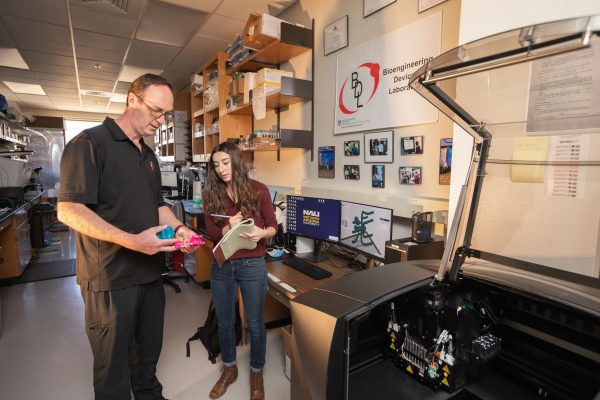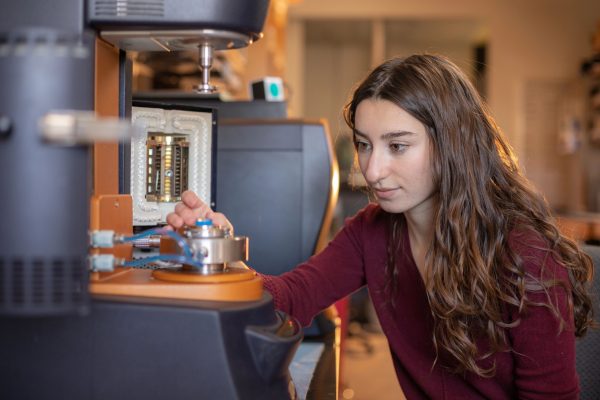Engineering the future of patient care
Josette Vigil, an NAU Mechanical Engineering major, applies bioengineering to advance medical device science.
Vigil, a Mechanical Engineering major in her junior year at NAU, advances medical device science and improves the outlook for stroke patients in Associate Professor Tim Becker’s Bioengineering Devices Lab (BDL). While she shares her work with the medical community in real time, Vigil is also taking it to the NAU and Flagstaff communities at NAU’s upcoming Undergraduate Symposium.
Bioengineering applies engineering principles and technologies to the fields of medicine and biology in order to improve patient care. This definition lives strongly within Becker’s on-campus lab. “The main emphasis of the lab is stroke research. We’re working on new ways of treating different types of stroke that occur in patients from as young as in their teens all the way up until old age,” Becker says.
Vigil, an undergraduate researcher in the lab and recipient of the Urdea Undergraduate Research Award, is advancing several projects targeting stroke treatment.
“My work is focused on two main areas. One is material testing and characterization of various 3D printed polymers, even tissues—we’re trying to develop a benchtop vessel model that best emulates human vasculature. The other main aspect of what I do is algorithm development.”
Vigil explains that the lab has “produced a device that fills an aneurysm so that blood flow no longer gets in, and it doesn’t burst. Essentially, you inject the device into the aneurysm, it hardens, and blood can’t get in anymore.”
Vigil’s algorithm development has a direct impact on patient care. “Right now, I’m working on a code that takes in a set of computerized tomography (CT) images. Using those images, the code can define the volume and the dimensions of an aneurysm,” she says. Knowing the volume of the aneurysm leads to more effective treatment; with it, medical providers can inject the correct amount of liquid into the aneurysm and prevent bursting. More concise diagnostic tools like these can lead to an improved outlook for stroke recovery.
Vigil presented a poster on the initial results of her diagnostic algorithm at the international conference of the Society for Neurointerventional Surgery (SNIS) in July 2021. On April 22, 2022, she will present on the next stages of the two separate projects—a working benchtop blood vessel model and a poster on her coding and algorithm development—at NAU’s annual Undergraduate Symposium. The presentations will be the latest product of Vigil’s meaningful experience in undergraduate research—a journey that began with a simple detour from classroom to lab.
“I actually had [Becker] as a professor. I remember going into the lab and thinking, ‘This is very different than what I was expecting.’ Your professors are just so cut and dry when you’re in classes. It was really cool to get to know a different side of my professors that was not just the little square during class on the online screen. That was definitely exciting,” she recalls.
Gaining lab skills
From that first day, Vigil’s skills in the lab improved exponentially. “I remember coming into the lab, and everything was so complicated and so overwhelming. Now an undergrad coworker and I are at a point where we know how almost every piece of equipment in the lab operates. When other people come in, we’re the ones explaining it to them, helping show them how to do things, or explaining the science to them. Versus when we started, it was, ‘I’m never going to understand this science. It is so beyond me. It is so beyond my understanding of what I can learn.’ I would say the most surprising part about being in research is that you’re learning so much without realizing that you’re learning so much while you’re doing it,” Vigil says.

The extension of classroom-to-lab learning was important to Vigil. “It’s allowed me to apply a lot of the things that I’d learned in the engineering program to something I was more interested in. Being able to see an application of knowledge from my degree was really exciting to me. It was what made me stay in the lab,” she says.
Becker echoed the importance of student involvement in research. “The most beneficial part from my perspective is to give the students that real-world experience. We try to make it applicable, what you’re learning in class to what you might do in the real world, but there’s so many different things that you can do as an engineer. There are so many different opportunities, it’s hard to give students that hands-on experience in the classroom,” he says.
This real-world research experience for students extends beyond future career opportunities, and closely parallels the cutting-edge development of their models, algorithms, and other lifesaving work.
“Josette’s project is a good example because she’s actually using real scans, from patients that we get from the Barrow Neurological Institute in Phoenix. She’s analyzing them to understand the size of their aneurysm, and what device might be the best fit for treating that aneurysm. NAU may not have a medical school, but we work directly with residents and neurosurgical fellows at Barrow,” Becker notes. Real-world application in the lab shows researchers like Vigil what they can achieve.
The lab’s researchers get additional opportunities for direct contact with medical providers and regulators through regular dialogue with the Food and Drug Administration (FDA) and face-to-face conference discussions.
“There’s a conference where I try to take all my students, even my undergrads. Josette has been there as well. At the conference, all the neurosurgeons come together and say, ‘This is the patient I worked with three months ago. And this is what I tried, and it worked great.’ And another one says, ‘This is what I tried, and it did not work.’ We get all these great ideas as engineers and say, ‘I think we can make that better.’ We can also talk directly to that neurosurgeon and say, ‘We were thinking about this kind of system. Do you want to work with us and see if we can come up with a better way to treat this?’” Becker says.
Vigil has gained valuable experience from these projects, combining her engineering degree—from coding to machinery—with human impact. “If someone took a CT of my brain, they could make a model based off it. It’s not cheap, but it can be done, which I think is incredible because it just takes a few grams of plastic to create. It’s not gold. It’s not a precious metal that we’re using. But it is so valuable in this sphere of treatment and patient care.” Ultimately, Vigil’s research translates to the development of bright futures: her own, and that of the stroke patients whose care she’s helped to improve.
